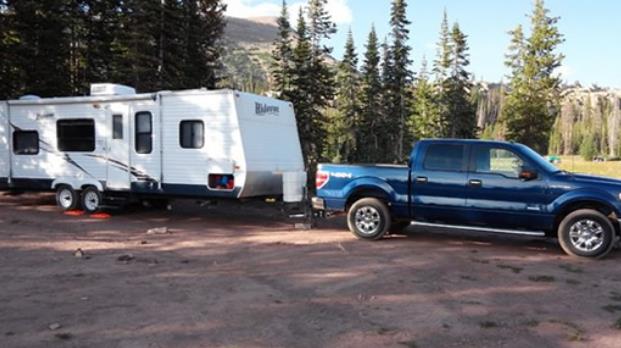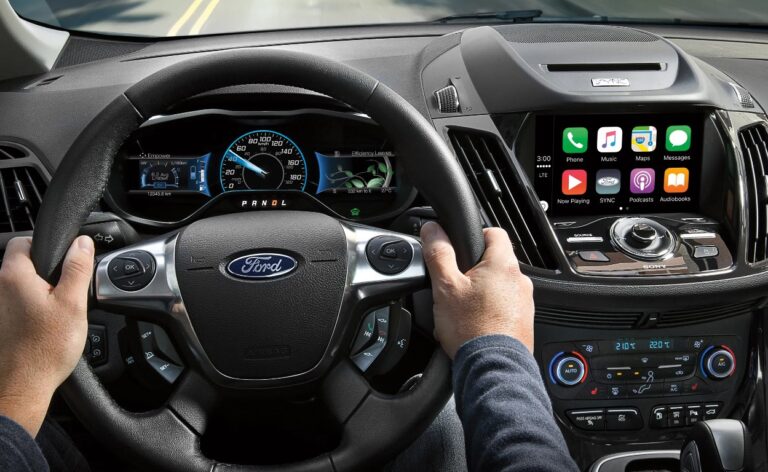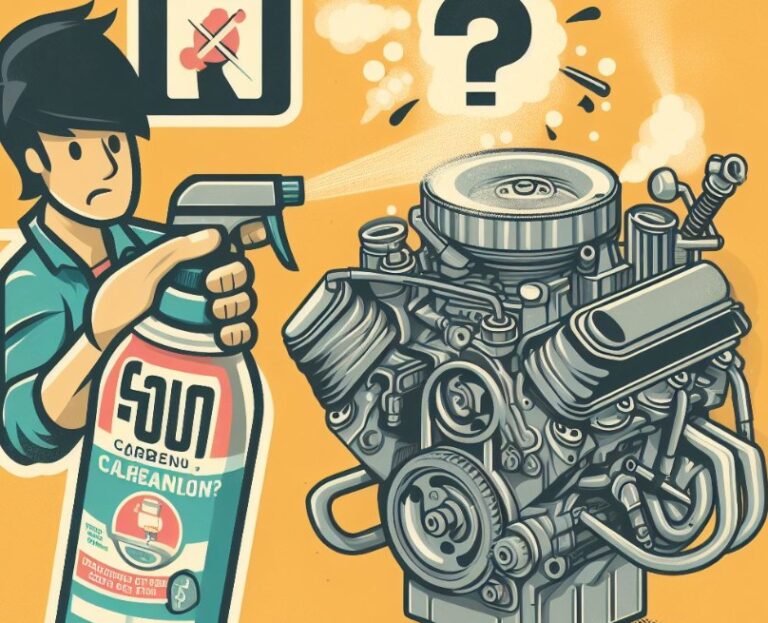How Fast Does A Skateboard Go? How Fast Do We Ride?
Are you looking for How Fast Does A Skateboard Go? This is a question that many skateboarding enthusiasts and newcomers alike often wonder about. The speed of a skateboard can vary based on several factors, including the type of skateboard, the surface you’re riding on, and your skill level.
Key Takeaways
- The average speed of a regular skateboard is around 8-12 mph.
- Electric skateboards can go up to 25-28 mph.
- Factors like surface, wheels, and rider skill affect speed.
- Safety gear is crucial when aiming for higher speeds.
- Speed wobbles are a common issue at high speeds.
How Fast Does A Skateboard Go?
The average speed of a regular skateboard ranges from 8 to 12 mph. Electric skateboards can go much faster, with some models reaching speeds of up to 25-28 mph.
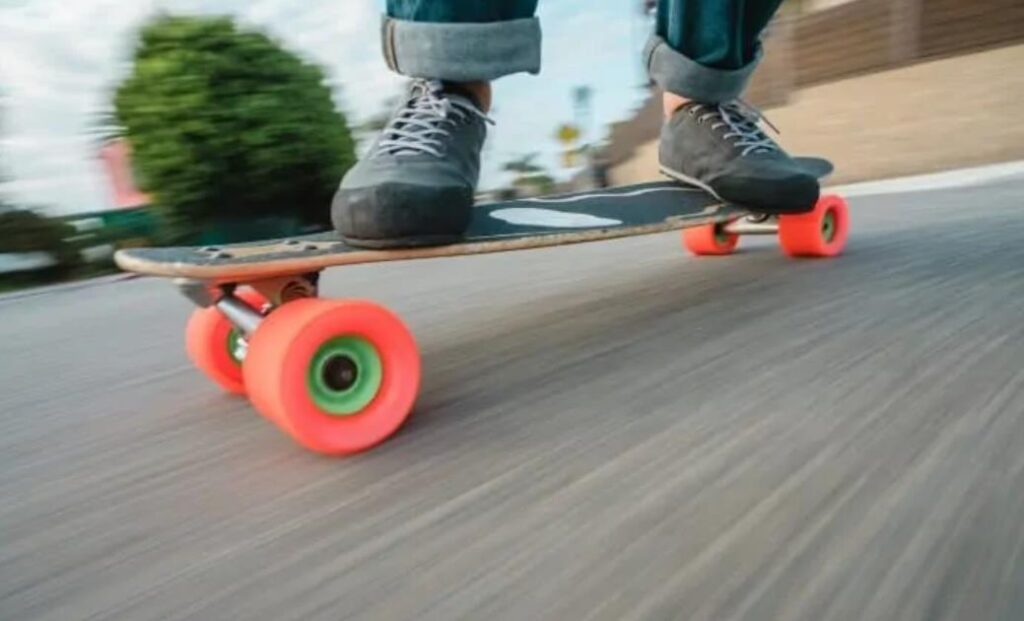
Factors Affecting Skateboard Speed
Understanding the factors that affect skateboard speed can help you optimize your ride for maximum velocity.
Whether you’re a casual skateboarder or a competitive athlete, knowing these variables can significantly improve your performance. Here’s a detailed look at the key factors that influence how fast a skateboard can go.

Type of Skateboard
Different types of skateboards are designed for various purposes, and their speed capabilities can vary widely.
- Standard Skateboards: Generally used for tricks and short commutes, they are not built for speed.
- Longboards: Designed for cruising and downhill racing, longboards can achieve higher speeds.
- Electric Skateboards: These can reach speeds up to 25 mph, depending on the model.
Quality of Bearings
Bearings play a crucial role in determining the speed of a skateboard. High-quality bearings reduce friction, allowing for a smoother and faster ride.
Wheel Size and Material
- Size: Larger wheels can cover more ground but may require more effort to start moving.
- Material: Softer wheels offer better grip but may reduce speed on smooth surfaces.
Riding Surface
The surface you’re riding on can significantly impact your speed.
- Smooth Surfaces: Ideal for higher speeds.
- Rough Surfaces: These can slow you down and require more effort to maintain speed.
Rider Skill Level
An experienced rider can maintain higher speeds safely, while a beginner may need to go slower to stay in control.
Wind and Weather Conditions
- Headwind: Can slow you down.
- Tailwind: This can increase your speed.
- Wet Conditions: Can make surfaces slippery and reduce speed.
Rider’s Weight
Heavier riders may find that they can achieve higher speeds downhill but may struggle with speed on flat surfaces.
Safety Gear
While not a direct factor, wearing aerodynamic safety gear can marginally improve speed by reducing wind resistance.
Maintenance
Regular maintenance like cleaning the bearings and wheels can also contribute to a faster ride.
Understanding these factors can help you make informed decisions about your best skateboard setup and riding conditions, ultimately allowing you to reach your desired speed safely.
Safety Measures for High-Speed Skateboarding
Skateboarding at high speeds can be exhilarating, but it also comes with increased risks. Ensuring your safety while pushing the limits of speed is crucial. Here’s a comprehensive guide on the safety measures you should take when skateboarding at high speeds.

Protective Gear
Wearing the right protective gear is the first line of defense against injuries.
- Helmet: A must-have for any skateboarder, especially when going at high speeds.
- Knee and Elbow Pads: These can protect you from severe injuries during falls.
- Wrist Guards: Useful for protecting your wrists if you fall and try to catch yourself with your hands.
- Slide Gloves: Essential for downhill skateboarding where you might need to put your hands down to slide.
Pre-Ride Inspection
Before you start your high-speed skateboarding session, inspect your skateboard thoroughly.
- Check the Bearings: Make sure they are in good condition and well-lubricated.
- Inspect the Wheels: Look for any signs of wear and tear.
- Tighten the Trucks: Loose trucks can lead to “speed wobbles” and loss of control.
Speed Control Techniques
Knowing how to control your speed is crucial when skateboarding at high velocities.
- Foot Braking: Dragging one foot on the ground to reduce speed.
- Sliding: An advanced technique to reduce speed by turning the board sideways and sliding along the surface.
- Carving: Making ‘S’ turns to control speed downhill.
Awareness of Surroundings
Being aware of your surroundings is crucial when skateboarding at high speeds.
- Visibility: Make sure you can see far enough ahead to react to obstacles or changes in the surface.
- Traffic: Be aware of other people, vehicles, or skateboarders around you.
- Surface Conditions: Wet or uneven surfaces can be particularly dangerous at high speeds.
Speed Wobbles
Speed wobbles are a common issue at high speeds and can lead to falls if not managed properly.
- Lower Your Center of Gravity: Bend your knees and lower your body.
- Shift Your Weight: Move your weight to the front of the skateboard.
- Grip the Board: Use your feet to grip the board firmly.
Emergency Procedures
Know what to do in case of an emergency, such as how to fall safely to minimize injury or how to quickly steer away from obstacles.
Types of Skateboards and Their Speeds
Different skateboards are designed for various purposes, and their speeds can vary accordingly.
| Type of Skateboard | Average Speed (mph) |
|---|---|
| Regular Skateboard | 8-12 |
| Longboard | 10-16 |
| Electric Skateboard | 25-28 |
How to Increase Your Skateboard Speed?
Increasing your skateboard speed isn’t just about pushing harder or going downhill. Several factors and techniques can help you achieve a faster ride while maintaining control and safety. Here’s a guide on how to effectively increase your skateboard speed.

Upgrade Your Bearings
One of the most straightforward ways to increase your speed is by upgrading to high-quality bearings. Look for bearings with a high ABEC rating, as they are designed for high-speed applications.
Choose the Right Wheels
The size and hardness of your wheels can significantly impact your speed.
- Size: Larger wheels cover more ground per rotation, increasing your speed.
- Hardness: Harder wheels reduce friction and are generally faster on smooth surfaces.
Optimize Your Board Setup
- Deck: A lighter deck can make it easier to gain speed.
- Trucks: Tightening your trucks can improve stability at high speeds, reducing wobbles.
Improve Your Pushing Technique
Your pushing technique can also affect your speed.
- Strong, Long Pushes: These can help you maintain a higher speed for longer periods.
- Switch Pushing: Learning to push with both legs can help you maintain speed without tiring one leg.
Aerodynamics
While it may seem minor, aerodynamics can play a role in your speed.
- Body Position: Lowering your body reduces air resistance.
- Clothing: Tight-fitting, aerodynamic clothing can make a small but noticeable difference.
Master Speed Control Techniques
Knowing how to control your speed can actually help you go faster safely.
- Foot Braking: Useful for controlling your speed without fully stopping.
- Sliding: An advanced technique for speed control, especially downhill.
Regular Maintenance
- Cleaning: Regularly clean your bearings and wheels to reduce friction.
- Lubrication: Use skateboard-specific lubricants for your bearings.
Training and Conditioning
Physical fitness can also impact your skateboarding speed.
- Leg Strength: Stronger legs can produce more powerful pushes.
- Stamina: Better stamina allows you to maintain higher speeds for longer periods.
Practice, Practice, Practice
The more you ride a skateboard, the better you’ll understand how to balance and control your board at higher speeds. Experience is invaluable when it comes to increasing your speed.
Advanced Techniques for Speed Control
Speed control is an essential skill for skateboarding, especially when you’re pushing the limits of speed. While beginners may rely on basic methods like foot braking, advanced skateboarders use a variety of techniques to control speed with precision. Here’s an in-depth look at advanced techniques for speed control in skateboarding.

Sliding
Sliding is a popular technique among downhill skateboarders for reducing speed quickly and efficiently.
- Pendulum Slide: This involves swinging the back end of the board out and then back in, resembling a pendulum.
- Heelside Slide: In this slide, you turn the board while digging your heels into it, causing the board to slide sideways.
- Toeside Slide: Similar to the heelside slide but using your toes to initiate the slide.
Pre-Drift
Pre-drift is a technique used before entering a turn to reduce speed. It involves initiating a slide and then gripping it back up to navigate the turn.
Air Braking
Air braking is effective at very high speeds and involves standing upright on the board and spreading your arms to increase wind resistance.
Carving
While carving is often used for fun and style, it can also be an effective way to control speed. By making large ‘S’ turns, you can reduce your speed gradually.
- Heelside Carving: Leaning back on your heels while turning.
- Toeside Carving: Leaning forward on your toes while turning.
Speed Checks
Speed checks are quick, small slides that help you reduce speed slightly. They are often used in downhill skateboarding to maintain a consistent speed.
Early Grab Airs
This technique involves grabbing the skateboard with your hands and jumping off a ramp or incline. The time spent in the air reduces speed slightly and is often used in downhill racing.
Tucking
While tucking is generally used to increase speed, adjusting your tuck can also help control it. A lower tuck will make you go faster, while coming out of the tuck slightly can help reduce speed.
Pumping
Pumping is a technique used in transitions or on-ramps to gain speed without pushing. However, it can also be used in reverse to shed speed by absorbing energy instead of generating it.
Foot Placement
Adjusting your foot placement can also affect your speed. Placing more weight on the front foot can increase speed while shifting weight to the back foot can help you slow down.
Speed and Skateboard Maintenance
Regular Check-Ups
To maintain optimal speed, it’s essential to regularly check the condition of your skateboard. Look for any signs of wear and tear, especially on the wheels and bearings.
Lubrication
Proper lubrication of the skateboard bearings can significantly improve speed. Use skateboard-specific lubricants for the best results.
Speed Records in Skateboarding
Skateboarding speed records are a testament to what is achievable with skill and the right equipment. The current world record for the fastest speed on a skateboard is 91.17 mph, set by Kyle Wester.
Speed and Skateboarding Styles
The speed you can achieve on a skateboard is closely tied to the style of skateboarding you engage in. Different styles have different speed requirements and limitations.

Understanding these can help you choose the right equipment and techniques to maximize your speed in your chosen style. Here’s a breakdown of how speed interacts with various skateboarding styles.
Downhill Skateboarding
Downhill skateboarding is all about speed. Riders can reach speeds of up to 50-60 mph or even more.
- Equipment: Specialized boards with lower centers of gravity and larger, softer wheels are often used.
- Techniques: Advanced speed control techniques like sliding and pre-drifts are essential.
Freestyle Skateboarding
Freestyle skateboarding is less about speed and more about tricks, balance, and technical skills.
- Equipment: Smaller, lighter boards with harder wheels are common.
- Techniques: Speed is often controlled through quick turns and pivots rather than slides or carves.
Street Skateboarding
Street skateboarding involves navigating urban environments, often at moderate speeds.
- Equipment: Versatile boards that are light enough for tricks but sturdy enough for various terrains.
- Techniques: Quick stops and starts, along with the ability to control speed in tight spaces, are crucial.
Park Skateboarding
Skateboarding in a skatepark often involves a mix of speed and tricks.
- Equipment: Boards are generally well-rounded to accommodate a variety of features in the park.
- Techniques: Speed is often gained through pumping in bowls and ramps.
Vert Skateboarding
Vert skateboarding involves skating on a vertical ramp and is more about airtime than speed.
- Equipment: Wider boards with more surface area for stability in the air are common.
- Techniques: Speed is gained through pumping at the transitions of the ramp.
Slalom Skateboarding
Slalom skateboarding is all about navigating a course of cones as quickly as possible.
- Equipment: Specialized boards designed for quick turns and agility are used.
- Techniques: Precise control over speed is required to navigate the course efficiently.
Cruising
Cruising is about relaxed, low-to-moderate-speed skateboarding.
- Equipment: Longboards or cruisers with softer wheels for comfort are common.
- Techniques: Speed is generally maintained at a constant, comfortable level.
Speed and Skateboarding Competitions
Skateboarding competitions often have speed-based events, such as time trials. In these events, speed is a critical factor for winning.

Time Trials
In time trials, skateboarders race against the clock on a set course. The fastest time wins.
Speed Runs
Speed runs involve completing a course as quickly as possible, often involving various obstacles.
Speed and Skateboarding Culture
The quest for speed has always been a part of skateboarding culture. Whether it’s breaking speed records or just the thrill of going fast, speed is deeply ingrained in the skateboarding community.
How Fast Can A Skateboard Go Downhill?
Downhill skateboarding is a style that focuses on speed, and it’s not uncommon for skateboarders to reach impressive velocities. The fastest downhill skateboard speed record is held by Pete Connolly, who reached a speed of 146.73 km/h (91.17 mph) on September 16, 2017, at Les Éboulements in Quebec, Canada.

Achieving such speeds requires specialized equipment, techniques, and a lot of practice. The aerodynamic design is also a crucial factor, as Connolly spent considerable time in wind tunnels to perfect his suit, skateboard, headgear, and body position.
The average speed for skateboarding is generally around 9 mph, but downhill skateboarding can far exceed that, with speeds ranging from 50-60 mph or even more.
Impact Of Terrain On Average Skateboard Speed
The terrain you’re skateboarding on can significantly impact your speed. For instance, downhill skateboarding allows for much higher speeds due to the gravitational pull.
On flat land, the average skateboard speed is around 9 mph, but this can vary depending on the skateboarder’s skill and the board setup. Uphill skateboarding will naturally be slower due to the effort required to work against gravity.
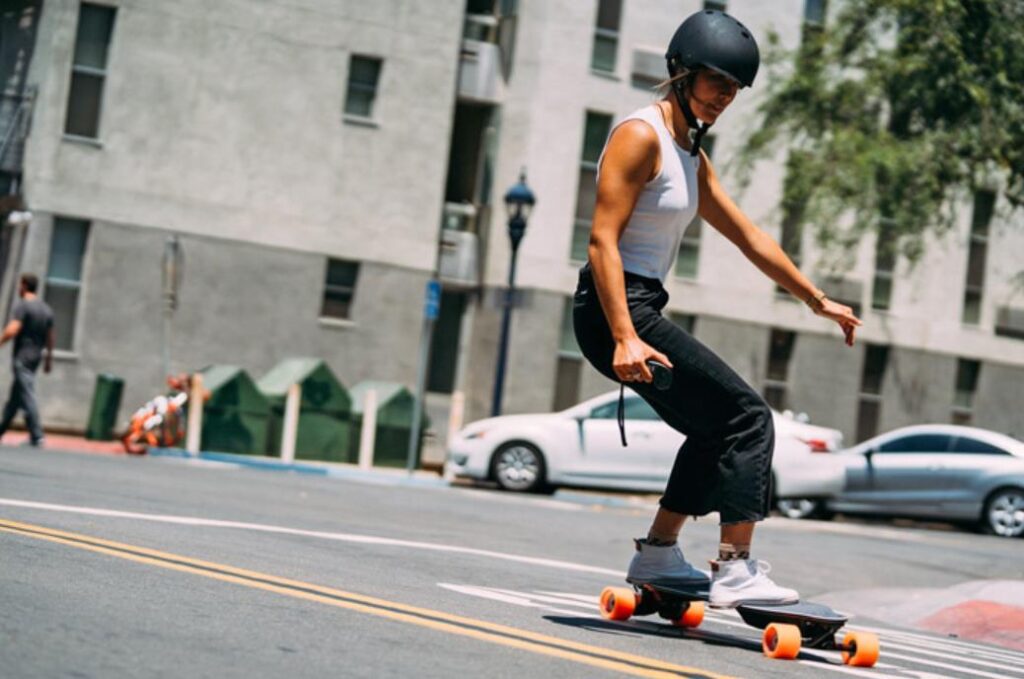
Different terrains like asphalt, concrete, or even rough trails can affect the skateboard’s speed due to varying levels of friction. It’s essential to choose the right skateboard setup based on the terrain you’ll be riding on to optimize your speed.
How Do Riding Skills Affect Average Skateboard Speed?
Your riding skills have a direct impact on the average speed you can achieve on a skateboard. Beginners often move at walking speed as they are still learning the basics.
As you gain experience, your speed can increase significantly. In crowded urban areas with uneven and cracked pavement, riding skills will affect speed even more. An experienced rider can easily dodge obstacles or even ollie over them.
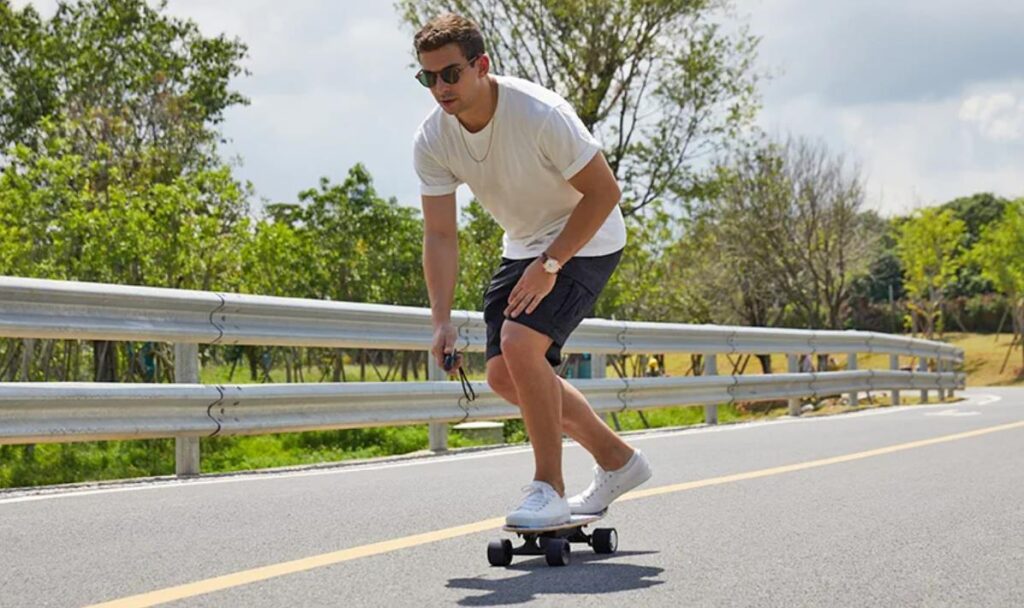
Your pushing skills also play a role; the intensity, effectiveness, and frequency of your pushes can significantly affect your speed. As your skills improve, you could add 1-2 mph to your average skateboarding speed, especially in urban settings.
Are Skateboards Faster Than Bikes?
When it comes to speed, skateboards generally lag behind bikes. The average speed for a bike is over 11 mph, compared to around 9 mph for a skateboard. However, this doesn’t mean skateboards can’t compete with bikes under certain conditions.
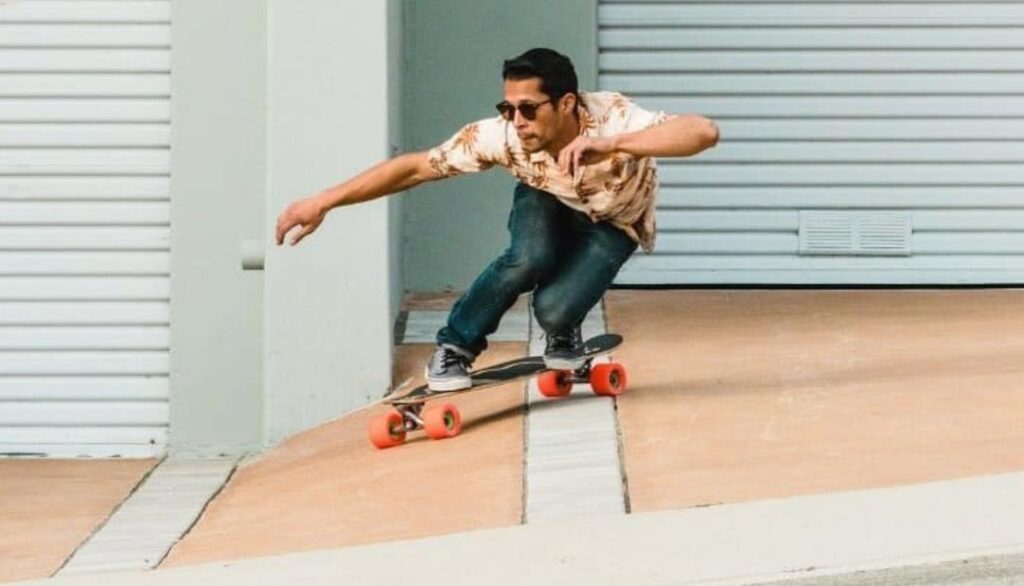
Skilled skateboarders with strong pushing skills can often ride at speeds comparable to or even faster than the average commuter on a bike. It’s worth noting that the type of terrain and the skill level of the rider can make a significant difference in this comparison.
Conclusion
In summary, the speed of a skateboard can vary widely depending on various factors such as the type of skateboard, the surface, and the rider’s skill level. The average speed for a regular skateboard is around 8-12 mph, while electric skateboards can go up to 25-28 mph. Always remember to take proper safety measures when trying to achieve higher speeds.
People Also Ask
Can electric skateboards go faster than regular skateboards?
Yes, electric skateboards can go much faster than regular skateboards, with some models reaching speeds of up to 25 mph.
Is it dangerous to skateboard at high speeds?
Skateboarding at high speeds can be risky if you are not experienced or if you are not wearing the proper safety gear. Always make sure to wear a helmet and other protective equipment.
Do softer wheels affect skateboard speed?
Softer wheels offer better grip but may reduce speed on smooth surfaces. They are generally better for cruising rather than speed.
Is there a speed limit for skateboarding in public areas?
Speed limits can vary by location and local laws. Always check the regulations in your area before skateboarding at high speeds.

Welcome to the exhilarating world of Matt Rex, a professional car racer turned renowned vehicle enthusiast. Immerse yourself in his captivating blog as he shares heart-pounding adventures, expert reviews, and valuable insights on cars, trucks, jets, and more. Fuel your passion for speed and discover the beauty of vehicles through Matt’s engaging stories and meticulous expertise. Join the ever-growing community of enthusiasts who find inspiration and expert advice in Matt Rex’s blog—a digital hub where the thrill of speed meets the pursuit of knowledge.



![How Far Can A Jet Ski Go Offshore? [Answered]](https://www.turbochaos.com/wp-content/uploads/2023/08/How-Far-Can-A-Jet-Ski-Go-Offshore-768x512.jpg)
